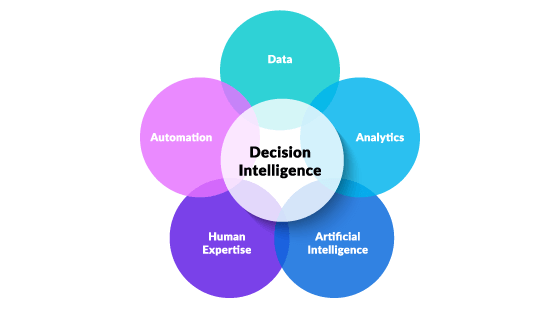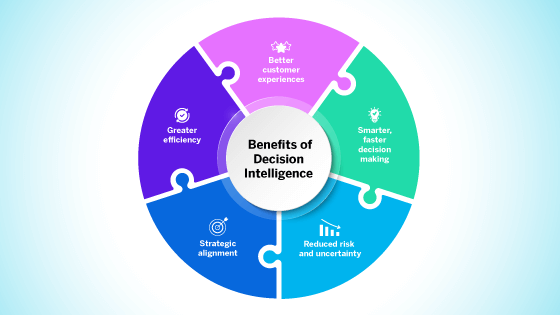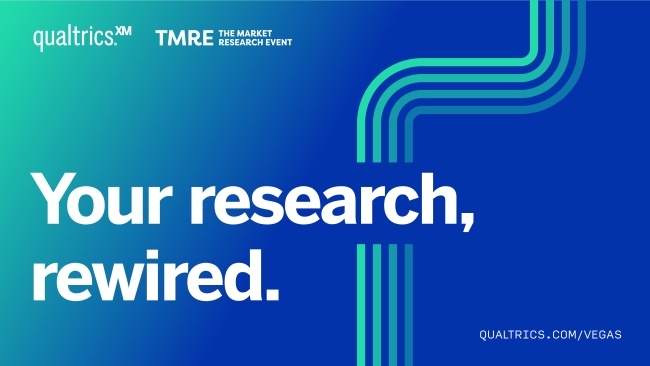What is decision intelligence (and why does it matter now)?
Decision intelligence (DI) is a new approach to solving a familiar problem: how to make better business decisions, faster.
It builds on the foundations of business intelligence (BI) but goes several steps further — bringing together data, analytics, artificial intelligence (including generative AI) and human expertise to guide decisions in real time and improve them over time.
While business intelligence focuses on describing what’s happened through dashboards, reports and performance metrics, decision intelligence is focused on what to do next. BI might tell you that sales have dropped in one region; DI would help you decide why it happened, what the likely impact will be and what actions to take in response.
Moving beyond business intelligence: A smarter approach to decisions
Decision intelligence couldn’t be arriving at a better time.
While business intelligence has long helped companies understand the past and present, the complexity of today’s business environment demands faster, more strategic responses than traditional BI tools can offer.
Decision intelligence, on the other hand, takes a more active role — shifting the focus from presenting information to actively shaping decisions.
Here’s how DI takes things further:
Business Intelligence (BI)
Decision Intelligence (DI)
Focus
Describes what is happening.
Focuses on what to do about it.
Scope
BI tools serve analysts and data teams.
DI empowers decision-makers across the business.
Intelligence
Provides insight.
Adds logic, strategy and automation.
The core components of decision intelligence
Decision intelligence represents an evolution of business intelligence, not an alternative to it.
DI builds on BI’s foundations and weaves in a combination of disciplines and technologies into one cohesive framework. Its power lies in orchestrating these powerful components to work together:
- Data: The foundation of DI. Structured data (like transaction records) and unstructured data (like customer feedback) are brought together to offer a complete view.
- Analytics: Advanced statistical models and Machine Learning techniques help extract patterns, identify drivers and forecast outcomes.
- Artificial intelligence: Including both traditional AI and generative AI. GenAI expands DI’s reach by generating synthetic data, simulating future scenarios and making insights more accessible to non-technical users.
- Automation: Enables insights to trigger actions automatically. From routing feedback to the right team to launching predefined workflows, automation closes the loop between analysis and response at both speed and scale.
- Human expertise: The component that can’t be overlooked: human input is key to framing the right questions, interpreting results and acting on recommendations. At its best, DI doesn’t replace human judgment — it enhances it.

Key benefits of decision intelligence
Decision intelligence enhances how organisations use data — not just by providing more insights, but by making every decision faster, smarter and more aligned to strategy.
Here are five of its most important benefits:
Smarter, faster decision making
In fast-moving environments, delayed decisions can mean missed opportunities. DI shortens the gap between insight and action by delivering real-time recommendations powered by predictive models and scenario simulations.
For example, a product manager launching a new feature can use DI to forecast adoption and test different rollout strategies — helping them avoid missteps and optimize outcomes before going live.
Reduced risk and uncertainty
DI helps organizations anticipate outcomes rather than react to them. By simulating future scenarios and modeling the impact of different choices, teams can make better-informed decisions under uncertainty.
A financial services firm, for instance, might use an AI-powered DI tool to model how interest rate changes could affect loan default rates — allowing them to adjust lending criteria before the risk materializes.
Strategic alignment
It’s easy to lose sight of broader business goals when decisions are made in silos.
DI addresses this by embedding strategic objectives directly into decision-making workflows, ensuring consistency and alignment across teams.
A customer support team, for example, might use DI to prioritize workflow automation initiatives based on their projected impact on core business KPIs like CSAT (customer satisfaction score) — making sure their work supports broader experience goals.
Greater efficiency
Teams often spend more time wrangling data than making actual decisions. But DI, by automating repetitive analysis and surfacing only the most relevant insights at the right time, can streamline data interpretation and operational efficiency.
For a retail company that spends a huge amount of staff time on manual checks, DI can automatically flag inventory imbalances and suggest redistribution strategies — saving human time and improving stock availability across locations.
Better customer experiences
Understanding customer needs is one thing — acting on them at scale is another. Here, DI can enable more responsive and personalized customer engagement by turning data signals into timely, tailored actions — ultimately improving retention, loyalty and customer satisfaction
A telecom provider, for example, might use DI to detect early signs of churn and proactively offer personalized retention incentives — boosting loyalty and reducing the cost of customer loss.

Artificial intelligence and decision intelligence
In today’s data-saturated world, the challenge for businesses is no longer a lack of data — it’s making sense of it all.
Organizations are grappling with fragmented systems, inconsistent data, and rising expectations for speed and precision. As digital transformation accelerates, decision intelligence is emerging as a true game-changer.
Artificial intelligence — particularly generative AI — is a powerful catalyst. But it’s decision intelligence that gives AI its direction.
Where AI excels at finding patterns, predicting outcomes or generating content, DI provides the framework to apply those capabilities to real business decisions. It ensures outputs are not just technically impressive but strategically useful.
By connecting data, logic, AI and human judgement into a single decision-making system, DI is now transforming the way organizations work — shifting insights out of dashboards to drive action in the real world.
How GenAI supercharges decision intelligence
Increasing the speed, scale and accessibility of insight generation, generative AI can dramatically boosts what decision intelligence can achieve. Here’s how:
Scenario simulation
Generative AI can create and test countless what-if scenarios in seconds. Whether you’re modeling supply chain disruptions or predicting future demand, it gives teams a faster way to explore potential outcomes — and prepare for them.
Synthetic data generation
Where real-world data is incomplete, outdated or unavailable, GenAI can create high-quality synthetic datasets to train models, fill gaps or safely simulate new market conditions.
Accessible outputs
One of GenAI’s great strengths is the accessibility it enables. Natural language processing enables GenAI to summarize findings, explain model outputs and draft recommendations in plain language — making advanced insights immediately accessible to many more people across the business.
Democratization
Rather than relying on specialists or BI teams to run queries, decision-makers at essentially all levels and of all specialisms can interact with data directly when using GenAI, speeding up the decision cycle.
But the real value comes when these capabilities are deployed within a decision intelligence framework. DI ensures that GenAI outputs are connected to business goals, embedded in decision workflows and continuously improved through feedback.
Decision intelligence in action: Key applications for businesses
Decision intelligence is more than a new layer of analytics. By combining data, AI and human judgement, it helps teams act with greater clarity, confidence and speed.
Here are four powerful ways organizations are putting it to work.
Revolutionizing market research
Instead of waiting weeks for survey results or ad hoc customer data analysis, teams can now tap into real-time market signals, track competitor movements and explore synthetic consumer responses to uncover insights instantly. With decision intelligence, it’s possible to answer questions like “What’s driving preference in this region?” or “Which competitor is gaining momentum?” — without launching a full study.
By simulating feedback from target audiences and layering in predictive analytics, organizations can make sharper, faster calls on everything from messaging to brand positioning.
Innovating product development
Decision intelligence can enhance every stage of product development — prioritizing features based on customer signals, validating concepts with synthetic personas and forecasting market response before launch. Connecting qualitative feedback with behavioral data, it can highlight unmet needs and spot friction points early.
Armed with decision intelligence, what once took teams months of testing and iteration can now be modelled, refined and acted on in days — speeding up go-to-market decisions and improving product-market fit.
Powering proactive strategic planning
Scenario planning has long been a cornerstone of strategic thinking but DI makes it dynamic.
With the ability to simulate future outcomes based on live data and generate multiple what-if scenarios, business leaders can test decisions against evolving conditions and adjust course in real time.
This approach turns strategy from a static annual process into an ongoing, responsive capability — aligned to both long-term goals and immediate shifts in customer sentiment, operational performance or external risks.
Strengthening risk assessment and mitigation
From operational disruption to reputational threats, DI helps teams see around corners better than ever before. With it, organizations can continuously analyze structured and unstructured data — like customer feedback, employee sentiment or supplier performance — surface hidden risks and take action early.
And with AI-powered insights, teams can understand not just what is happening, but why — enabling smarter mitigation strategies across the business.
The risks and considerations that come with decision intelligence
As decision intelligence becomes more embedded in how businesses operate, it’s important to understand not just what it enables, but also what it requires.
Like any system powered by AI and data, DI comes with its own risks. Managing these well is critical to building trust at every level, maintaining oversight and making sure smarter decisions don’t become riskier decisions.
Data bias, model transparency and AI “hallucinations”
AI models are only as good as the data they’re trained on — and biased data leads to biased decisions. If a model is trained on unrepresentative or historical datasets that perpetuate inequalities, DI systems can unintentionally reinforce them.
Transparency is another challenge. Complex models often act as “black boxes”, making it hard to trace how a decision was reached. This becomes even more difficult when generative AI is involved — where outputs might sound plausible but can be entirely fabricated. These so-called AI “hallucinations” can lead to massive issues if they go unnoticed.
Organizations adopting DI need robust data governance, diverse datasets and clear processes for validating AI-generated insights — especially when decisions carry high stakes.
Security, privacy and responsible AI use
Decision intelligence systems often pull in large volumes of data — from customer feedback to operational records. This makes security and privacy — both from external threats and unintended internal use — non-negotiable.
There’s also a wider ethical responsibility — especially if DI systems are used to influence decisions across hiring, lending, pricing and more. Without careful oversight, they can reinforce unfair patterns or overlook marginalized groups.
Responsible AI use means setting clear guardrails, ensuring compliance with evolving regulations and continuously monitoring how decisions are being made — and who they impact.
Maintaining human judgment in an AI-augmented world
Decision intelligence isn’t about replacing humans — it’s about supporting them. But when AI systems are highly capable and convincing, there’s a risk of over-reliance without applying the critical thinking or contextual knowledge that only humans can deliver.
The most effective organizations treat DI as a collaborative system — where AI handles the heavy lifting, and humans bring the judgement, nuance and accountability. This requires building AI literacy across the business, designing workflows that encourage human input, and making sure people still feel empowered to ask questions, challenge outputs and ultimately make the final call.
Getting started with decision intelligence
Adopting decision intelligence doesn’t require a complete overhaul — it’s a journey that starts with clear priorities and builds over time.
Whether you’re looking to simply solve business problems, align decision making or embed AI across the organization, the key is to take a structured approach.
1. Start with clear goals and strong data foundations
The first step is knowing what you want DI to achieve within your organization.
Are you trying to improve forecasting? Respond faster to customer trends? Reduce inefficiencies? Defining a small number of high impact use cases will help you focus your efforts and demonstrate value early.
From there, assess your data. Decision intelligence thrives on a combination of structured and unstructured inputs — so it’s important to map where your key insights currently live, and where there are gaps. You don’t need perfect data to begin, but you do need the ability to connect the dots across teams and systems.
Modern decision intelligence platforms that unify customer, employee and operational insights — and can automate workflows based on AI-driven recommendations — make it easier to move from pilot to scale without needing to bolt on multiple tools.
2. Build the skills and culture to support it
Technology is only one part of the puzzle. To get value from DI, people across your organization need to trust it, understand it and feel confident using it.
That means investing in AI literacy across your business — helping teams know when to rely on data-driven recommendations, when to dig deeper and when to apply human judgement. Decision intelligence becomes most effective when it’s not just used by analysts — but embedded in how product, research, HR and operations teams work every day.
When assessing your options, keep accessibility in mind: platforms that make it easy to interact with data in natural language, or summarize complex insights into plain English, can dramatically lower your internal barrier to adoption.
3. Plan for what’s next
Decision intelligence is evolving fast. Generative AI is already bringing speed and scale to insights — but the next wave will bring even more powerful capabilities. Soon, AI agents will be able to carry out complex tasks across workflows, while multimodal AI will combine text, voice, image and behavioral signals to paint a fuller picture of what’s happening — and why.
The most future-ready businesses are already putting the building blocks in place for what’s to come: choosing flexible platforms that support integration across systems, investing in responsible AI governance, and continuously upskilling their teams.
How Qualtrics approaches AI-powered decision intelligence
Decision intelligence is most effective when it’s embedded into the everyday systems where decisions are made — connected to real-time data, automated workflows and the people using them. At Qualtrics®, decision intelligence is enabled through the Qualtrics XM Platform™, where AI isn’t bolted on — it’s built in.
This integration means research insights don’t sit in dashboards. They trigger actions, power predictions and support decisions as they happen — turning structured and unstructured data into meaningful outcomes at scale.
Helping market researchers and product managers make smarter, faster decisions
With Qualtrics Edge, researchers and product teams can access decision-ready insights in minutes. Powered by synthetic data, predictive analytics and real-time behavioral tracking, it helps teams test concepts, explore competitive shifts and simulate customer responses without relying on lengthy fieldwork.
See it in action today and watch a demo of Qualtrics Edge working its magic
Decision intelligence FAQs
Decision intelligence is a fast-moving field, and naturally subject to lots of questions from those wanting to explore its potential. Here are some of the most common questions we hear, answered:
What’s the difference between decision intelligence and business intelligence?
Business intelligence (BI) focuses on describing what has happened — using dashboards, KPIs and reports to present historical data. Decision intelligence (DI) builds on this by connecting those insights to decision-making processes. It uses AI, predictive models and logic frameworks to recommend or automate the next best action, making it more proactive than traditional BI.
What’s the difference between decision intelligence and data science?
Data science is the discipline that creates models, algorithms and analytical techniques to extract patterns from data. Decision intelligence takes those outputs and embeds them into business decision flows — layering in strategy, real-time data and human context.
In short, data science creates the tools; DI ensures those tools are used to make smarter decisions.
How does generative AI help make better business decisions?
Generative AI enhances decision intelligence by making insight generation faster, broader and more accessible. It can simulate scenarios, fill gaps with synthetic data, and translate outputs into plain language — so teams don’t just get raw analysis, but ready-to-act recommendations. It helps businesses explore more options, spot blind spots, and act with greater confidence.
What are the first steps a company should take to adopt decision intelligence?
Start by identifying a few priority decisions where better insights could improve speed, accuracy or impact. Assess the quality and availability of your data, and look for technology that can unify sources, apply predictive models and surface recommendations.
Starting small — with a clear goal and a strong feedback loop — sets the foundation for scaling decision intelligence across the business.
Will decision intelligence replace human decision-makers?
No — decision intelligence is designed to augment human judgement, not replace it. AI can process huge volumes of data, model outcomes, and suggest next steps, but people are still essential for context, ethics and strategy.
The goal of DI is to give decision-makers better tools — not take them out of the loop.
Should decision intelligence replace business intelligence?
Not exactly. Despite the growth of decision intelligence, business intelligence is still essential for tracking performance, spotting trends and understanding what’s happened. Decision intelligence builds on that foundation by adding predictive modeling, automation and decision logic.
The two work best together — BI surfaces insight, while DI helps you act on it.



